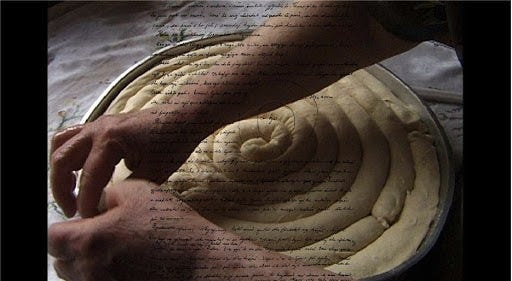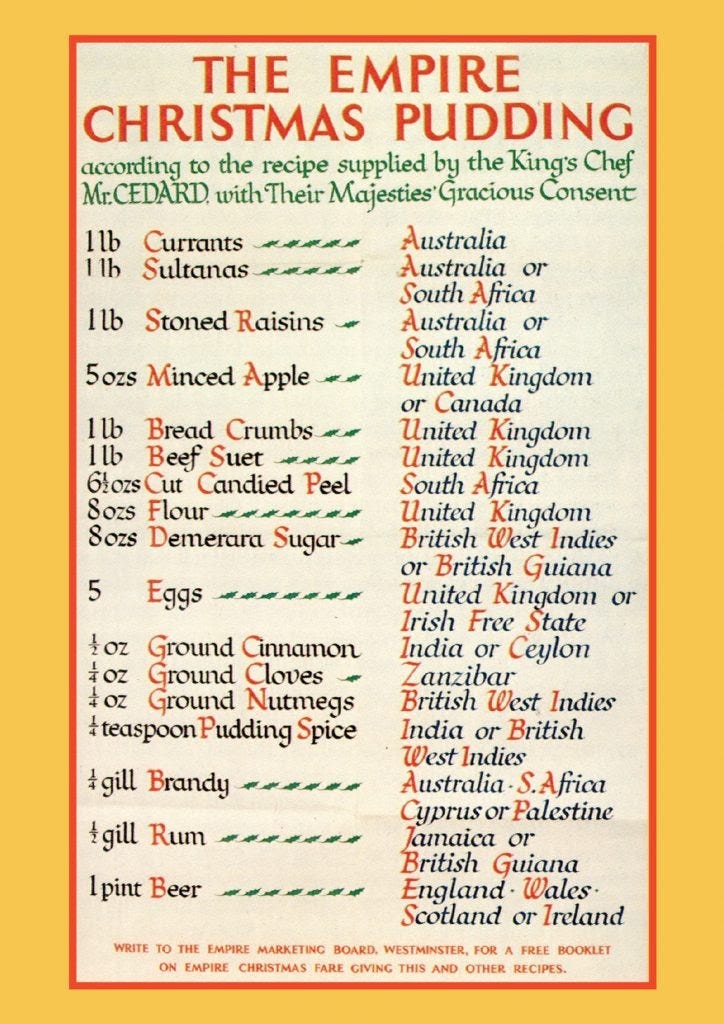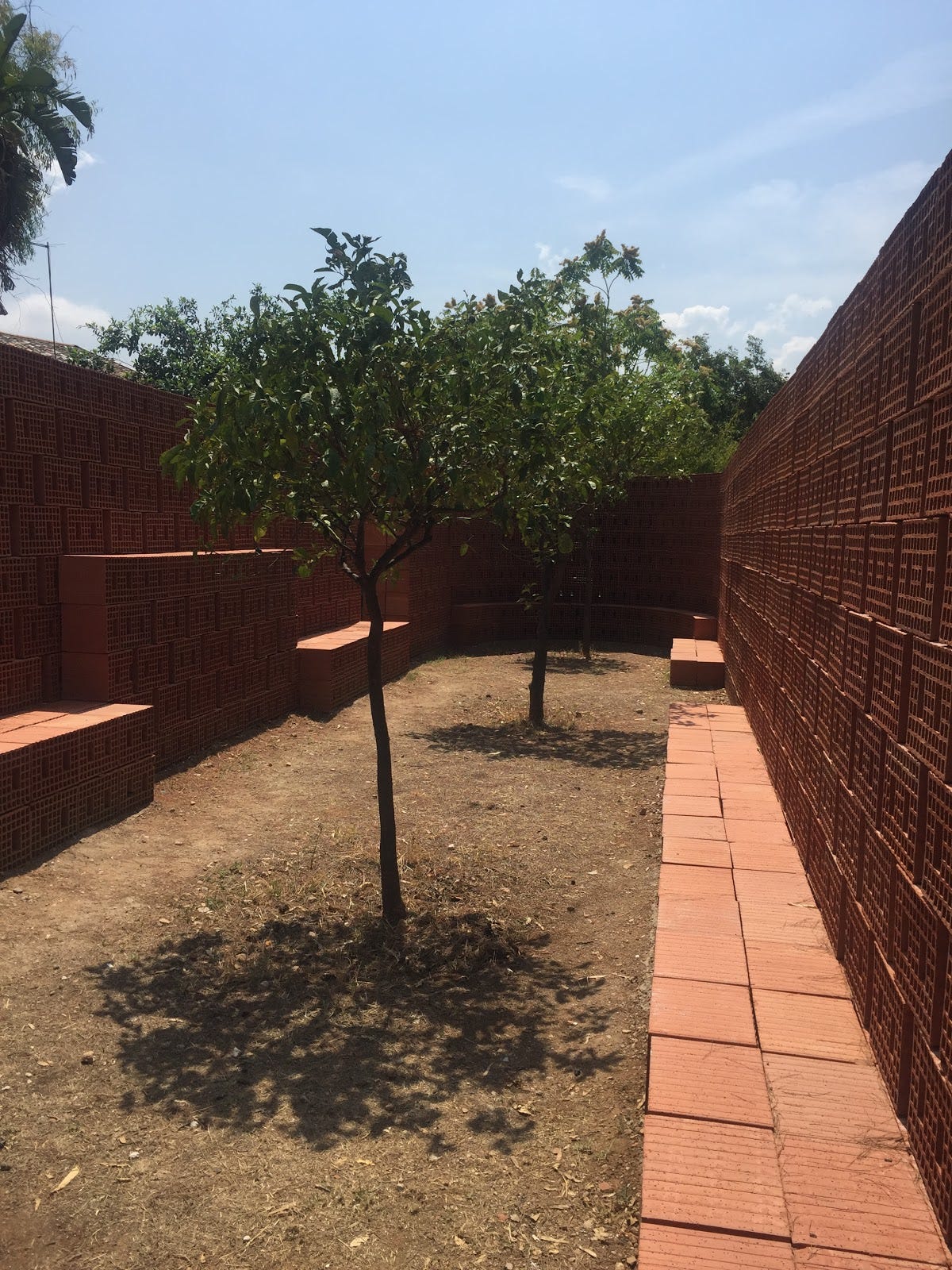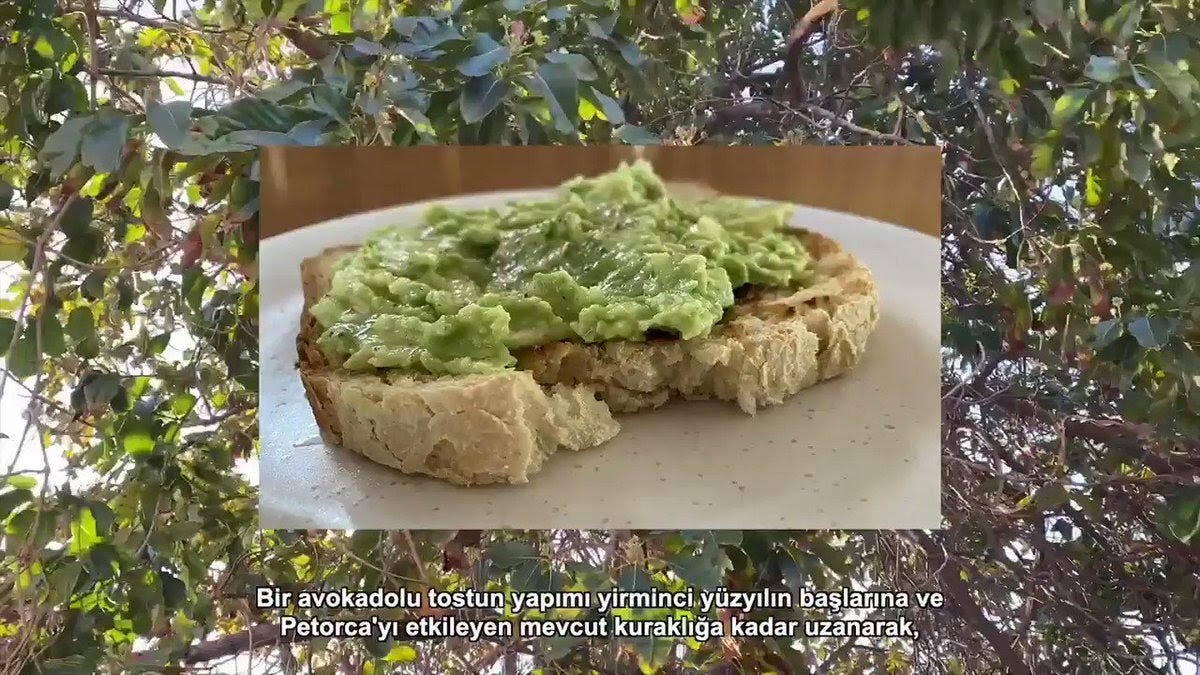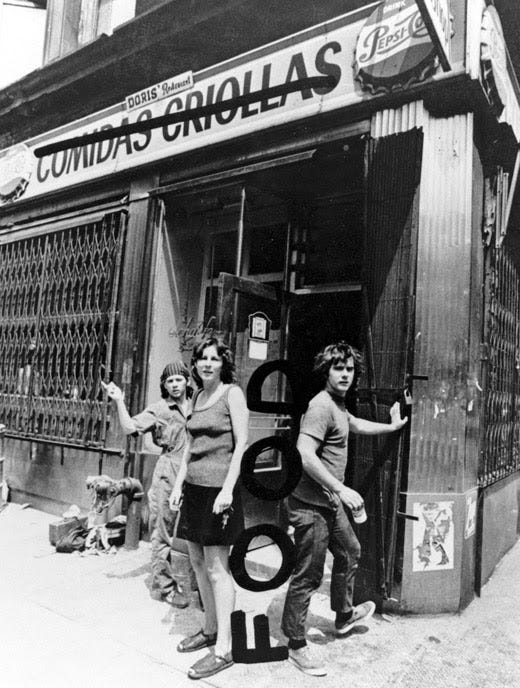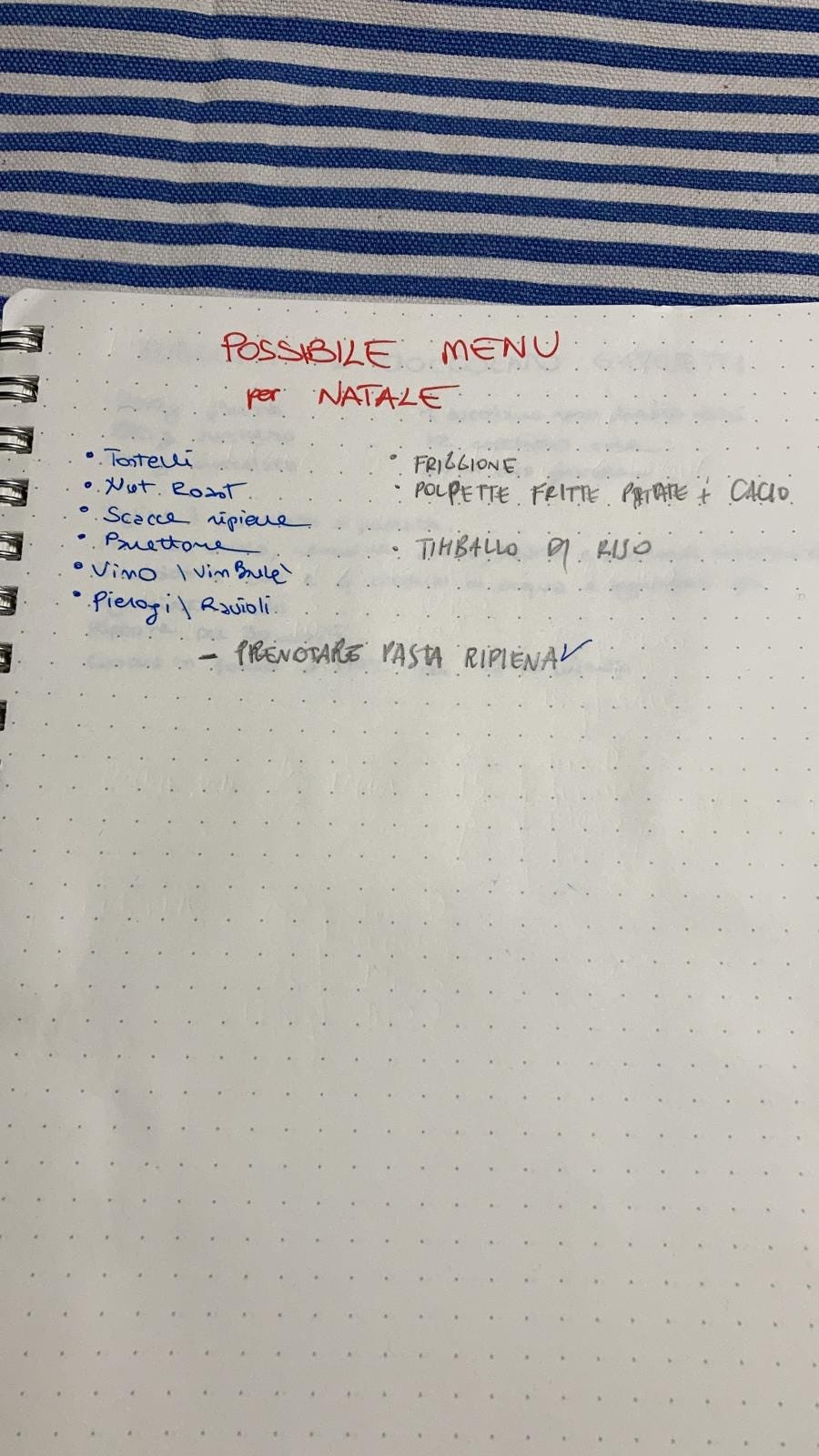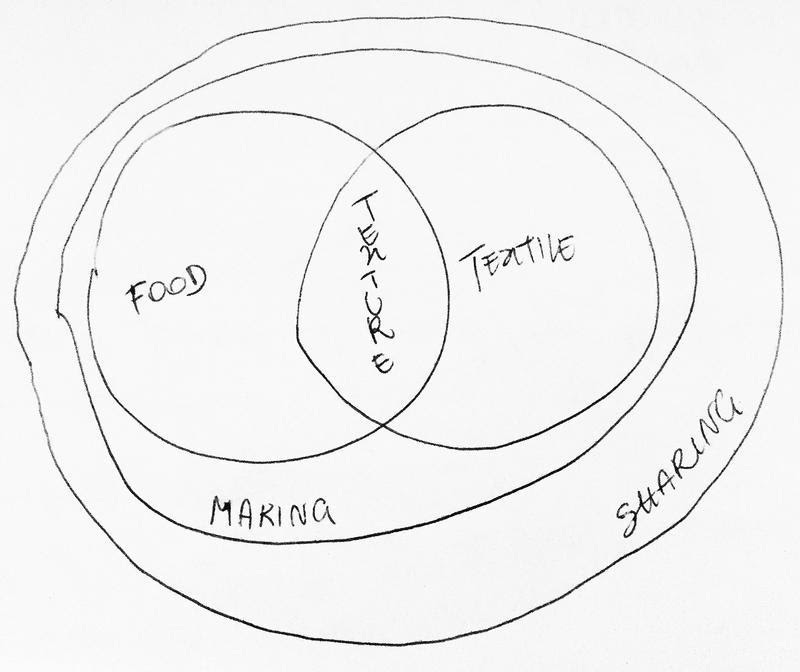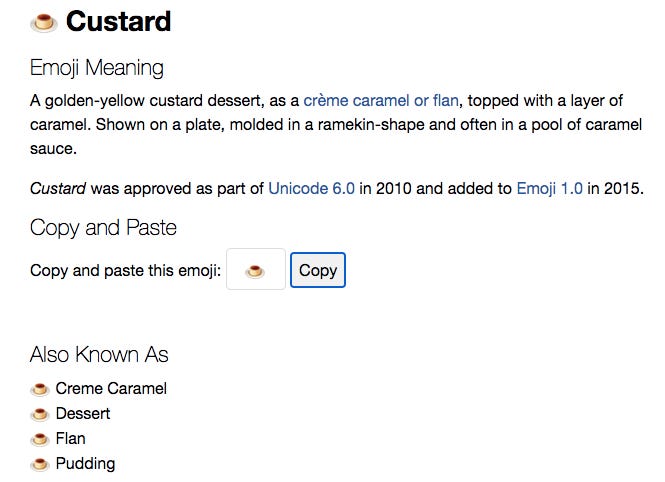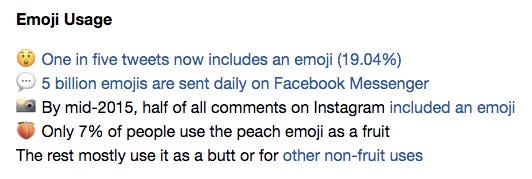#3 [EN]
sugar, spice, and everything nice
Welcome to the third issue of Interstizi,
a random newsletter born from the need to get together, and share reflections and thoughts outside a predefined space. An informal platform for comparison and research on art, pop culture and current affairs that we hope will open up over time to many different perspectives and modes of expression. A physical and mental space to germinate, deepen what is important to us, and tell something about oneself, find one's voice while also throwing some healthy rant.
In this issue we decided to get caught up in theChristmas spirit and talk about recipes 🍜 - culinary, artistic and emotional, the perfect mix for every holiday. As two people is love, but three is a party, we decided to multiply and invite Elena Braida and Alessandra Saviotti to tell us something about them, their research and their recipes.
Happy reading and happy holidays!
Fabiola & Giulia
Panorama
Recipes in transformation
I perceive the word ‘recipe’ as immediately connected to a domestic context, to family and to traditional regional cooking (for me, Sicilian). At the same time, I have a weird relationship with recipes: ingredients and processes always seem more like recommendations than rules, open structures to be molded according to my liking and my needs - which annoys people that, on the other hand, believe in following every little step religiously. It is a word so charged with emotional and personal meaning that I decided to look up its ‘objective’ definition (on Italian Wikipedia, from which I am freely translating). A recipe is a set of instructions given with the aim of operating a process of transformation that, through physical and chemical alterations of one or more of the ingredients, results in something different from the original substances, usually of higher value or utility than the actual ingredients.
This article starts from here, from the elements of this definition, as well as the elements that make up recipes: emotional, ritual, holy, and tasty.
The word ‘recipe’ is mostly used to talk about food and cooking, but it’s present in other contexts and figurative expressions, too - this is perhaps more prevalent in Italian, as ‘ricetta’ also indicates a medical prescription for example. The history of this word takes us back to Latin and the concept of ‘things taken’, collected and appropriated, accurately selected to operate a transformation, whose result exceeds each ingredient. There’s something magic and mysterious in this process, an unknown chemistry which reminds me of the casting of spells.
object*oriented*magic is a video by Ayşenaz Toker and Merve Tuna presented as part of e-flux’s Critical Cooking Show, a project in collaboration with the Istanbul Biennial 2020. In it, the recipes of three different magic rituals are revealed. The first one, *Divided They Fall* takes place in an office, using stationary and relying on the intervention of cats and dogs to annihilate hostile colleagues. *Winds of Change & Weeds of Sex* is a love spell, while *Delivering the Proof in the Policy of Truth* uses kitchen tools to take revenge against a hypocrite, giving them a taste of their own medicine. In the video, everyday objects turn into special ingredients which, assembled according to precise rituals, turn into magic and allow one to obtain extraordinary results. Magic is linked to deep emotions, visceral and rational at the same time, in ways that recall the relationship we have with food. In witchcraft and in the kitchen alike, we feel a connection to the earth, given by the ingredients which we use not only a means of sustenance, but also for their potential to turn things in our favour and to make us feel better.
The precise movements of hands and arms in object*oriented*magic evoke those of someone preparing a local recipe, perhaps for the hundredth time, in an endless repetition which is never boring and gets better every time. These hands and arms usually belong to a grandmother, but an almost collective one: someone who spends hours in the kitchen, cutting, mixing, kneading and baking, as part of their role of family glue. Grandmas, mothers and aunts are often gatekeepers of ‘tradition’, within families and wider communities alike, a very important role which, as it happens with emotional labour, is often taken for granted. One of the earliest works by artist Anri Sala is Byrek (2000), a 22 mins long video in which the strong hands and arms of a woman prepare, as per title, byrek, a stuffed Albanian bread. The on-screen text is the recipe, handwritten by Sala’s grandmother in Albanian and displayed without translation, making it indecipherable for anyone not speaking the language. The recipe stays secret, while gestures and procedures glue us to the screen (in fact, I still remember in spite of watching it ages ago, at an exhibition in Venice).
What is it about preparing food that enchants us in such a compelling way? Over the last decade, TV shows dedicated to cooking in all its variants have increased exponentially, while on the Internet it is almost impossible to log into any social media platform without finding pictures or videos showing the preparation of all sorts of foods. For many of us, these shows have a calming effect. The expert hands of someone weighting, cutting and preparing ingredients, mixing them in such a secure way, where there’s no hesitations or mistakes, have something hypnotizing, almost therapeutic.
At the core of any recipe lies the idea that, by following precise instructions codified over time and passed down through generations, we shall always obtain the same result. The first recipe found by archaeologists dates back to 1730 BC and comes from Mesopotamia, written in cuneiform script. The recipe is mostly a list of ingredients, plus some instructions, for a lamb stew: “Meat is used. You prepare water. You add fine-grained salt, dried barley cakes, onion, Persian shallot, and milk. You crush and add leek and garlic.” As much as it is brief and not very detailed, this recipe from 4000 years ago doesn’t even feel this ancient. After all, a stew is a stew, and an onion, a leek and garlic are all familiar ingredients that we still use frequently. The researchers who have decoded and recreated this and other recipes, dosing ingredients’ quantities and trying different methods and cooking techniques, have noticed peculiar similarities with the contemporary cuisines of Iran and Iraq, such as the combination of several spices to obtain complex flavours and the prevalence of stews and stuffed dishes.
Specific ingredients and procedures are strongly linked to the areas where they originated in such a way that food becomes a primary instrument of resistance and daily riaffermance of one’s identity. Palestinian artist Jumana Manna creates videos and installations that show us the relevance of different ingredients. Recently, her research has been focusing on foraging, its importance for the Palestinian community and the politics infiltrating it. Three species of spontaneous plants are favoured by Palestinians and Israelis alike: ‘akkoub, a cardoon similar to artichoke, referred to as ‘green gold’; za’atar, a wild thyme central to preparing many traditional recipes; and miramiyyeh, a spontaneous sage, traditionally consumed as herbal tea. In spite of these plants growing abundantly, over the years Israel’s Nature and Parks Authority made their picking illegal.
It all started with za’atar. In 1977, the ministry of Agriculture Ariel Sharon listed the species as protected, making its harvest illegal (if caught, lawbreakers can be fined or incarcerated for up to three years). This decision was presented in a positive light, as useful for conservation, but no scientific studies had conclusively proven that za’atar was an endangered species. In fact, after the new law was imposed, an Israeli kibbutz in Galilee started to grow huge amounts of za’atar, which was sold back to Palestinians dispossessed from this resource and even exported to neighbouring countries as a Palestian product. This project was initiated by Ze’ev Ben Herut, the former governor of Agriculture in the West Bank, who had spent time with Palestinians, learning the secret recipes of the best za’atar mix, traditionally prepared with varying quantities of wild thyme, sumac, sesame seeds and salt. This first example of Israelis appropriating a traditional Palestinian recipe, quickly followed by hummous, falafel and more, represents one of the many ways in which the violence of the occupation penetrates all aspects of daily life. Since the first law was passed to ban the picking of za’atar (and, more recently, of ‘akkoub and miramiyyeh) hundreds of people have been fined: all of them Palestinians.
Recipes and ingredients have strong political and symbolic value: they are so connected to deep emotions and to pride for one’s land and culture that they must be dominated in order to impose power upon other populations, as it’s been happening since the beginning of European colonialism in the 15th century. A colonialism that started out precisely as theft of other people’s ingredients. Through centuries, edible plants have travelled, either spontaneously or forcibly transported along commercial routes, growing in new environments and infiltrating the cuisines of nations far away from their places of origin. More often than not, these journeys have not been neutral or following an equal commercial exchange. In fact, they have been the complete opposite. One example amongst many might be that of spices such as cinnamon and nutmeg, grown in Indonesia’s Banda and Maluku Islands, whose commerce was monopolised by the Dutch in the mid 17th century through massacres so brutal to be nowadays considered as one of the first examples of deliberate genocide. The cultivation of sugar, coffee and other ingredients (‘colonial goods’) caused the deportation, enslavement and death of millions of people. Still today, food production is linked to horrible human and animal exploitation - but this is a story for a different article.
For their project The Empire Remains Shop, the duo Cooking Sections (Daniel Fernández Pascual & Alon Schwabe) re-created a colonial shop through an installation and a book to investigate the histories of ingredients such as ‘exotic’ fruit, sugar, spices, coffee and more, thus highlighting the impact of colonialism on a global network of crops, ingredients, and exploitation. Amongst the recipes revisited by the artists we find the Christmas pudding. Published in 1928 by the Empire Marketing Board within a plan to promote the consumption of colonial products, the recipe features 17 ingredients, all coming from different regions. By remaking it today, the artists realised that some of these regions don’t even exist anymore or they don’t produce the same exports: with independence, countries have formed in different ways or have changed their economy and crops.
In their ongoing project Climavore, Cooking Sections reflect and unpack the assumption that, by gathering a list of ingredients and following an established procedure, we shall always obtain the same meal, even if centuries have passed. After all, as I was writing before, a leek is a leek. But how does this hold true when traditional ingredients can’t grow anymore, because of climate change? Climavore aims at creating a new understanding of traditional recipes that will sooner or later have to forgo their immobilism to become more flexible and experimental and adapt to different climates, reflecting in different farming. Since 2015, the artists have been exploring different locations and traditions, from the Dead Sea to South Tirol, from Sicily to Skye Island in Northern Scotland. Through collaborating with agronomists, engineers, biologists, nutritionists and other experts, they have prepared menus that consider the emergence of new climate conditions. Sicily, for instance, has become a producer of tropical crops such as mangoes, papayas and avocados, due to the tropicalisation of its climate over the past years. At the same time, drought remains an important issue that farmers have to face. In their iteration of Climavore for Manifesta 12 in Palermo, Cooking Sections recreated ancient irrigation techniques, including one invented on Pantelleria island in the Middle Ages. The menu, too, started from tradition and focused on ingredients traditionally grown for their resistance to drought which are now less common, including ancient grains, carob and manna. The past can still have relevant answers.
The unsustainable nature of the global food system is at the core of The Avocado Toast, a video by Chilean artist Linda Schilling Cuellar. Following the instructions to prepare a perfect avocado toast, the artist puts together various ingredients tracing the recipe for the destruction of the Petorca river region, where avocados are grown in monoculture plantations. In Chilean cuisine, avocado is used for many traditional recipes, including of course spreading it on a piece of bread as a quick snack. This simple dish went viral on Instagram about 5 years ago, heavily featuring on the feeds of influencers and celebrities, thus becoming one of the most desidered ingredients. The global appetite for avocados, coupled with the ignorance of how and where they are produced, has caused the exploitation and subsequent destruction of some of the most fertile lands in Chile, as well as loss of money for locals who bought land in a region that is now infertile. Built as a glossy TV cooking show, Schilling Cuellar’s video prompts us to consider not just our unsustainable food choices, propelled by Instagram, YouTube and TikTok, but also the way in which a food item once considered traditional drastically becomes global to the detriment of local farmers and people.
The act of cooking, of selecting ingredients and mixing them together, is neither neutral, nor definite. Yet, there’s something universal in the gestures, emotions and feelings that we associate to it. Gathering to cook together, sharing not only our favourite foods but also our recipes, are all at the core of our sociality. Not by coincidence, during the recent/ongoing lockdowns and hard times we have all been experiencing, many of us found refuge in the kitchen. During the March lockdown, baker’s yeast was almost impossible to find in Italian supermarkets for several weeks, as the whole nation was kneading and baking, trying to recreate the feelings of safety and contentment that we often associate with cooking and following recipes. The kitchen is a primary place for exchange, story-telling, and forging inter-generational alliances -- perhaps even a place where other sorts of alliances are possible.
Between 1971 and 1974, Carol Goodden, Tina Girouard and Gordon Matta-Clark ran FOOD, a restaurant located in the then unattractive New York neighbourhood of SoHo. As artists started to move to the area, the three wanted to open up a place for gathering, eating, working and getting a wage. FOOD didn’t have a set menu, with dishes changing on a daily basis and decided by guest chefs (which, amongst the years, included Robert Rauschenberg, Donald Judd, Joan Shapiro, Yvonne Rainer and many more), with the only limitation being low prices. At one point, the restaurant was serving about 100 meals each day, often offering very weird recipes, such as “Alive”, a dish invented by Matta-Clark which included living brine shrimps swimming in egg whites. Other meals were less unusual, such as the chili prepared by Rauschenberg, or more aesthetically pleasing, as when green pasta was served with red sauce, and red pasta with green pesto. Goodden had the idea of not having a fixed menu, so that customers could always try something new and that ingredients could be sourced locally and flexibly. For many artists, FOOD became an extension of their studio. Matta-Clark, for example, made one of its first architectural interventions here, as well as shooting one of his first films, A Day in the Life of Food, documenting the activities at the restaurant from early mornings at Fulton Fish Market to the making of bread at dusk. As soon as FOOD started to become successful on a commercial level, its founders lost interest and sold it to new management, which ran the restaurant until its closure in the 1980s.
In the years that FOOD was active, many feminist artists were engaging with ideas of the personal as political, stating that all aspects of life, food and cooking included, have political, artistic and collective relevance. FOOD became a place of gathering for activists engaged in different fights, including feminism, the Black Power movement and LGBTQIA+ rights. The restaurant was a place for active experimentation of new social, political and economic systems, taking place through practical, daily actions that had a very different feel and scope to writing, protesting or making art. As in recipes, the people participating in the project and their daily work to make it function became the ingredients of this collective experiment. Artist Suzanne Harris, who was very involved in FOOD, thus described what was going on in the kitchen and communal areas of the restaurant: We didn’t need the rest of the world. Rather than attacking a system that was already there, we chose to build a world of our own.
Nice to meet you
This month we decided to try something new! So, we started a conversation with Elena Braida, an Italian artist based in Amsterdam. Here are some fragments of our exchange.
Giulia
Here is the group! ✨✨
Fabiola
🍧 hey
Hi Elena, starting from the idea of a recipe, do you have a personal definition? What are your favorite recipes (of any kind)?
Elena
Hello :)) well, I’d like to resume my thesis, titled "The Carrier Bag of Recipes", in which I indeed reported the definition of recipe taken from the Treccani dictionary:
‘The recipe is a set of instructions to activate a general process of transformation, which through various alterations of one or more basic substances (ingredients), both physical (produced by actions) and chemical (produced through mixing and changes of substances), would result in something different from the original elements, usually of greater value or usefulness than the ingredients themselves'.
The concept of recipe is not something foreign to us. We use them in our daily life, consciously or not. Consider the instructions given by your grandmother on how to cure a sore throat, or the prescription received from your doctor, which allows you to buy antibiotics for your sore throat at the pharmacy. "An apple a day keeps the doctor away!" a variation of the proverb "Eat an apple when you go to bed and you will prevent the doctor from earning his bread", which was a popular 19th-century expression in Wales. A great example of how a proverb can also serve as a recipe, in this case a recipe for staying healthy.
The ancient meaning of recipe comes from the Latin word 'recepta', a neutral past plural participle of recipĕre which literally means "things taken", since in medieval Latin the description of processes usually began with the instruction to "take "the various ingredients. Therefore, the imperative "recipe" is an instruction "to take" the following items (of the ensuing list). In English, "recipe" is nothing more than the first word of each recipe, which functions as a command. Take the following ingredients (to) get something. A + B = C, this is the equation for a recipe.
Initially, while researching for resources and definitions, I noticed that in other languages and especially in English, these definitions always fell into the culinary sphere. This annoyed me a lot, because in Italian for example we have other uses of the word in different contexts. The medical prescription for example. And when I picked up the Italian vocabulary and read this definition I had the feeling of having done a kind of checkpot. 'The recipe is nothing more than a set of instructions' - then I started thinking and counting every time I found myself in the situation where I have to do a set of instructions. And there I realized that it happens every day. Take for example the rules of conduct within a group, or within a company. Or the school rules, the Friulian proverbs, the artistic posters, the life advice of the grandmothers... All of a sudden RECIPES WEW EVERYWHERE!
So, I started talking about it openly, with my friends of the same age, professors, artists etc. And I started collecting recipes of all kinds which I eventually included in my publication. One of my favorites is that of my Roman grandmother. The ingredients are: sadness, sugar and strawberries. When I was little and I was crying or sad, she would run to the supermarket to buy strawberries and then make me a bowl full of sugar with whole strawberries in it, pointed down, as she repeated 'this combination is the taste of sweet girls'. So I stopped crying, because I stopped thinking about bad things and tried to identify with those sweet girls, hoping to have that taste. Like a short story, a good recipe can put us in a pleasant ecstasy, because it gives the opportunity to enjoy it in our mind. There is no need to perform it or wait to have it under your eyes (or mouth) to appreciate it.
*I took this picture a month ago, during my last cry
A source of culinary and non-culinary inspiration, Rachel Roddy. https://instagram.com/rachelaliceroddy?igshid=amgayd5j1rab
Giulia
Yees, she awesome!
I find myself very much in this! When I started writing the article for this issue, I had the impulse to go and look for the definition of 'recipe' as well, because with all the emotional and profound meanings that I associate with this word, I seemed to no longer know what it really meant. The definition immediately made me think of magic, how ingredients both in the kitchen and in magic become something sacred and ritual while being ordinary things.
But how do you feel about the instructions given by the recipes? Because I am honestly almost unable to follow a recipe step by step, I always end up doing as I want to, taking the rules very flexibly (while my boyfriend gets nervous because he wants to follow everything literally) - how do you position yourself? Also, I’m very interested in your favorite recipes!
Fabiola
I’m not able to follow any recipe in the culinary field, and it is strange because I generally tend to trust external indications. In the kitchen, all the rules get skipped, I don't feel the pressure of having to succeed in something and I like to start with a recipe and then follow my instinct. Of course, it almost never works, but I enjoy it a lot more 🤸♀️
I really like this recipe from Nonna Romana. It makes me think a lot about my grandparents and the way food often replaced words. Whenever I was sick, my grandfather would bring me a hot herbal tea with cynar (*artichoke liqueur) and didn't say much. I never really drank it, and for a long time it confused me, but I realized over time that it was his way of awkwardly making me feel his presence. It's as if recipes (for me) are disconnected from the final result. They represent a ritual that has value in itself.
Giulia
My strongest memory of an almost magical ritual happened when I had sunstroke as a child and my grandmother treated me with a ritual for "levari or suli" - she placed a small basin with water and olive oil on my head, in which she then put a small candle in a glass. I remember water sizzling around the hot glass, while the sun was removed ... it obviously worked
Fabiola
What are your non-culinary recipes instead? @Giulia, do you remember the pre-exam pomegranate?
Giulia
I was just thinking about it!
*good night!
Elena
Oh my dears, between reading and making a recipe there is an entire universe of sensations, feelings, thoughts and secrets in the middle. And in fact, I have to say that I really like getting lost and letting myself go to this universe rather than trying to literally reproduce the recipe. Forgive my absence but an absurd coincidence occured, tomorrow I will organize a creative / impulsive writing workshop to investigate the methodology of cooking with the Artez master class in Arnhem! Craaaazy
Giulia
That’s great!! You have to tell us how you will organize it and what will come out of it!
Fabiola
Good morning Elena, good morning Giulia ☀️ how are you?
How did the workshop at Artez go? I’m really curious. Do you often work in this laboratory way? Or is it something new?
Hugging you while thinking about lunch 🍝
Elena
Hello beautiful! Everything is fine here in Amsterdam: cold rain and skyrocketing humidity. The only thing that cheers me up are sage and orange peel infusions.
I have to say this week has really surprised me. Immediately after your dear invitation, I received 3 other proposals, including that of the workshop, all of them inspired by my publication. WOW! I think you called them for me ..;))))))
The workshop was beautiful, the first year of this master is now undertaking a module oriented towards writing and developing the artist statement. They try to investigate and understand what are their values, expectations, intentions, both as artists, designers and individuals and as a group or collective. So, I took over this module and presented my publication. By giving more attention to how I cultivated the methodology of recipe writing, I used it as a basis both for my essays and in my practice as a designer.
Immediately after the presentation, we started with impulsive - creative writing exercises, that I developed during the writing of my thesis to 'start' writing. Not being a native English speaker, I'm never sure of the words I use. The problem was not what or how to write but more starting. So, I started to time myself and write on impulse for 2-3 minutes everything that went through my head about a given 'ingredient', or topic. On Thursday I asked the students to bring 2 physical and 2 non-physical ingredients (emotions, movements, actions). The first round consisted of writing for 3 minutes on an A4 sheet of everything that went through our head while looking at the physical ingredient. At the end of the 3 minutes, both the ingredient and the sheet with the previously-folded-text were passed to the neighbor. At the end of this step, each student had 10 different texts on their ingredients in their hands, 10 different points of view of their object and this also served to understand how their ingredient is perceived by others, from the outside. After that, I asked them to write a recipe for 7 minutes, using that ingredient-text along with the non-physical one.
The last step was to take this recipe and give it a physical space - the city, the school, the house and so on. The idea behind this workshop was to get them familiar with this writing process. And encourage them to replace the ingredients they brought with their values or products and aspirations in order to impulsively reflect on their needs as artists and designers.
And yes, it was really cool! Especially getting feedback and seeing how institutions here are interested in calling alumni to talk about their work. For two days I have only been thinking about wanting to teach, and to do so here in Holland I should have a Master's degree.
Giulia
How beautiful!! Super happy for you Elena ❤️🧿✨
Elena
*Looking at the photos, it’s hilarious no one has brought food
Fabiola
Really interesting Elena! Was it the same for your artist statement? How would you describe your artistic evolution so far?
I love walking around in supermarkets, watching food repeat itself in different shapes and colors and look inside other people's baskets. They are all potential recipes, things that are there, waiting to be transformed into something else. But also an infinite and suffocating repetition of merchandise. Depends on how you see it
Elena
To go back to the artist statement… I hated that assignment. I thought I could not summarize all my interests, the techniques I use and the materials in a few paragraphs. We started working on it already from the second year, very early for me. I must say that the lockdown helped me a lot to carve out some time and reflect on what I was missing, about school, workshops, friends etc etc. And then I realized that what I missed most was not producing but sharing with my fellow students. When I decided that my practice as a designer and artist was based on sharing - collaboration - togetherness - debate, I then realized that starting from there I could range.
And now that we are in full lockdown here in Amsterdam, I am very sad. First the decision not to return to Italy...and now that I was happy to spend Christmas here with friends, start new traditions, have an 8-hour Italian lunch..now we unfortunately have the limit of 3 people at home and I guess we'll have to do a week-long Christmas marathon to eat and see us all.
How are you organizing yourself? I don't know, the idea of Christmas between intimates goes against my morals,Christmas is not meant to be among a few, no ?????????? Anyway I can't wait to be a pissadaliere! A focaccia covered with onions, anchovies and black olives!
* and lasagnas, tiramisù, apple sorbets to digest, and mulled wine :)))))))))))))
Giulia
🥺🥺
Here too they are changing their minds and perhaps there will be stricter / almost lockdown rules. I won't be having Christmas with my family for the first time either, so I want to try to recreate some family recipes that we usually make, like scacce (Sicilian stuffed focaccia)
Fabiola
I will spend Christmas with my parents and maybe a little bit with my cousins and uncles, who live downstairs. It will certainly be a different Christmas, with many missing pieces and traditions. I think Christmas is really interesting because it is a celebration full of recipes. Recipes on what to eat, how to dress, what and how to play, the little recipes / personal traditions of each one for every moment of the day. A party that is in itself a recipe that brings together many material and immaterial ingredients. At first glance, it may seem strange how much the political discourse was centered around Christmas in such a difficult moment but I think it is indicative of how many emotions are related to this holiday. In addition to the need to be together with the people you love.
What are your emotional recipes?
Giulia
These are my boyfriend's and my assumptions for the Christmas and holiday menu
Elena
Brava Giulia, I think I'll write down some ideas in the morning too. I'm eating canned corn and the last few vegetables in the fridge so as to make room for the Christmas shopping. Here in Amsterdam there is a shop called 'Appetito' and it has all Italian things. I caaaaaaaaan't wait to grab everything.
Mmmm emotional recipes mmmm. I noticed that when I miss someone I think of the dishes / dinners we have had together / repeated several times. Or the dishes they prepared for me. As a lot of friends moved after Graduation, now I really like redoing their dishes and sending them pictures, like 'LOOK! I miss u !!!!! Cause I'm cooking what you used to make !!!! '
With my roommate, we have created several rituals, if we are down we call each other in the morning and drink coffee together, if we want to talk about our work instead we call each other after dinner. I don't know if they fall into the emotional recipes category but if I think about it I perfectly recognize what emotional state I am referring to, melancholy, happiness, relaxation.
You Fabiola?????
Fabiola
I asked you something I’m not able to answer myself hahaha
The more I think about it, the more I can think of little things I do when I'm alone - maybe because I'm spending this week alone and away from home. Every time I change cities, there are things that I carry with me or that I do that I usually never do at home, like drinking a certain type of coffee or eating certain things. It amazes me how my breakfast completely changes, not so much for what I eat but for the things I do.
In the end, it always comes back to food, even when we talk about emotions
However, these days I always wake up singing this song
Elena, Giulia, how did moving to another city affected your research and the perception of your work?
Giulia
Complex question! For me, each relocation has given more energy as change is my element (while I struggle with routine). Every place, situation and people I met are all ingredients that enriched and made my research more and more special, taking it in different directions but still united. For example, I have always had a huge interest in architecture and the way in which space is created, organized, represented, making some things possible and others not. Returning to Italy, I started to think more about the size of the body (not neutral) in space and very much also about nature and its processes (food included hehe)
Elena
Aaaaaaaaaah difficult question. I fell in love with Amsterdam from the first trip, for the architecture and especially for the bikes haha after a few months I had a culture shock when I realized that here the culinary culture was not appealing, almost absent. I must say, however, that the Rietveld was a surprise. It is a bit of a bubble, but since there are students from all over the world it is a continuous and very interesting cultural exchange. I still live in this bubble and who knows if I will ever adapt to Holland. Now that I graduated, I looked back and I think .. wow I'm a craftwoman (ehehe). An artisan. And it amazes me that I managed to produce and carry out so many different projects here. Knowing that if I had studied in Italy, being the most academic (correct me if I'm wrong), I would certainly not have taken this path. Does it make sense?
Giulia
Here is my new recipe for starting the days - for about a week now - fishing from the tarot deck and letting yourself be guided by the flow of chance and infiltrating new energies and thoughts! I usually draw one major arcana every few days and one minor arcana every day
Elena
Ooooooo I've always wanted to learn how to read the cards! Although routine kills me too and I'm a huge fan of spontaneity, I love astrology.
Fabiola
But what should be the recipe for a good education as an artist? And once you leave the academy?
Obviously I'm not talking about a recipe for success ✨ also because we should discuss what success really is. I think about it every now and then and I'm really happy with the path I took because it was a bit like fusion cuisine, so many ingredients from different cultures plus my personal touch and my inability to really follow a recipe.
Recipe for disaster 🍝
Elena
Ahahah I love this
I dare say .. that the recipe for an excellent / satisfying school path is to forget about the recipe and focus on your ingredients. Values, materials, interests, platforms, colleagues, collaborations. And then, once you're out experimenting with these ingredients and making recipes. Take the degree project and test it, outside of the university environment, take the objects produced and review them in another light, show them etc etc, and the recipe will make itself!
This is my recipe
Giulia
it comes to mind when different ingredients are mixed in the kitchen, even with a recipe, but then in any case there is always an underlying unpredictability: there is never the certainty of a precise result, these are transformations that we can never entirely control - in the end the recipe actually ends up making itself! How do you leave room for chance in your practices and in thinking about the future?
Fabiola
I am learning to leave room for chance, it is not something I can easily do, I like to have things under control. This last year hasn't left me much choice - I think it's been like that for everyone. So I decided to apply to life the same philosophy that I apply to cooking, to follow my gut and start mixing things, even if I'm not sure of the final result. And definitely mix as much as possible, without prejudice about what can fit together or not. I don't know if it's already working, but I can say that in the kitchen it doesn't always end well 🐸
Elena
Returning to your question, I must admit that I also like having everything under control. Situations, love life, planning everything down to the smallest detail. But I don't know why, the kitchen is the only space where I let myself completely go to the ingredients. I have noticed that now that I am trying to make room in the fridge for Christmas shopping, I have been cooking improbable things for a week or rather, I have been creating combinations that I would never have consciously chosen. Leaving aside the dishes themselves - more than once they were quite sad - it amazes me how in situations like this I manage to get by and combine things together following only the memory of the ingredients in my gut. In fact, I am pleased to see that it is always possible in some way to create or give a twist to a dish or even just an ingredient. It makes me feel pragmatic.
Giulia
*I wanted to share this with you, Elene you inspired my with your recipe
Elena
❤️ ❤️ that’s beautiful, I see myself a lot in these passages
***
Elena Braida (1994), Udine, IT. Live and work in Amsterdam for 5 years now, where she recently completed her studies at the Gerrit Rietveld Academie of Fine Arts and Design with specialization in textile. She is currently investigating the relationship between culinary and textile practices under the name of her research STUDIO BONOMIA1.
1bonomia /bono'mia/ s. f. [dal fr. bonhomie, der. di bonhomme "buonuomo"]. - [being simple and meek in soul and manner]
Interludio
one more article - This month written by a special guest, Alessandra Saviotti
Comfort food, memories and emojis
While cleaning my closet one afternoon I found a Jolly Rancher in the pocket of an old jean jacket. It was from Trevor’s truck. He always kept them in his cup holder. I unwrapped it, held it between my fingers. The memory of our voices is inside it. “Tell me what you know,” I whispered. It caught the light from the window like an ancient jewel. I went inside the closet, closed the door, sat down in the tight dark, and placed the candy, smooth and cool, in my mouth. Green Apple.🍏
Ocean Vuong (2019), On earth we’re briefly gorgeous, London: Penguin Press
My mother lost hers when she was 17 years old and my grandmother's cookbook is what she treasures the most. That book, with its almost unreadable and discolored pages, represents an inestimable value for her. In fact every year during the traditional Christmas lunch at my aunt’s, when the moment of the creme brulee comes, you can hear my mother almost whispering between herself: ‘It has the same flavour of mama’s creme brulee’ 🍮
Most probably this year I am not going to make that lunch, like the rest of the family, so I am about to arrange a shipment from Italy: a box full of my favourite comfort food to trigger that particular feeling I have only during winter holidays.
Creme Brulee should be there too
Anyone who knows me well enough, is aware of how much I love the place where I was born, Romagna. In every city I have lived, I tried to build a community who somehow reminded me of my hometown through friendships, stories, running on the beach (in case I was living somewhere close to the coast), epic nights out at the disco; however food, well it clearly plays a special role in all of this. My comfort food is ‘piadina’, a very simple kind of flatbread, typical of the areas around Ravenna, Rimini, Forli, on the North-Eastern coast of Italy. Usually it comes with meat, cheese and vegetables but my favourite is completely plain. When I used to live in San Francisco, I discovered some Romagnolo fast food restaurants run by two brothers from Rimini and a guy from Cesenatico. They had an open kitchen where you could see the cool-tattooed ‘sfogline’ making pasta so that everyone could witness the magic. Once I went with a friend - also from Romagna - who ordered ‘cappelletti al pesto’ (which sounds like an anathema since you eat them either ‘in brodo’ or ‘al ragu’): they refused to serve him because they spotted his accent and thought it was unacceptable to even think about that dish. This is one of my favourite anecdotes because it represents that very specific, radical and anti-fusion attitude associated with the fact that ‘you don’t want to mess up with food in Romagna’. Especially if you think about the context of the United States where ‘customer is always right’. In Amsterdam I immediately looked for a ‘piadinaro’, indeed one of the first photos I uploaded on my Instagram feed it’s me biting into a piadina at Waterlooplein. In Brussels, I had my weekly meeting with the ‘piadinare’ at the Saint Gilles Monday market, they always came with their yellow (or perhaps orange) food truck. Well, I think you get it.
Comfort food: does it exist in an Italian translation?
No, it does not (at least I am not satisfied with what I read). Some think that the reason why it does not have any translation both as concept or as an expression, lies in food’s cultural perception in Italy: it always represents pleasure. I do not necessarily agree, I don’t think one can generalize on peoples’ feelings towards eating. Food could become a refuge or even help who suffers from psychosis for the immediate feeling of relief it causes. Trying to recap a bit, comfort food, means something that triggers a very specific feeling, sometimes nostalgic, while we eat or simply smell a particular dish. Like creme brulee for my mother, for example. Or the madeleine for Marcel Proust, Or the green apple for Ocean Vuong.
I had a survey among my Instagram followers (💌) and I received many different answers, however almost all of them where about a very specific memory related to a relative (mostly grandmothers) and a hometown: the potato gateau, the piadina, nutmeg, and so on.
With only a few exceptions (vegetable soup), almost everyone mentioned a very heavy food, rich on carbs, fat and fried. Because of the role that food had within evolution, it is associated with the strongest feelings that affect both the body and the mind.
‘if you’re a creature that lives in the wild, where food is often scarce, discovering a source of high-calorie or fatty foodstuffs, things that provide abundant metabolic energy, having a tendency to consume as much of it as possible and add it to your bodily stores regardless of when and what you last ate would be a survival advantage.’
From comfort food to its emoji
I tried to identify the emojis corresponding to ‘piadina’, ‘cappelletti’, ‘lasagna’, ‘focaccia with mortadella’, ‘passatelli’ and they are not there. But I wanted to know the reason why a particular food is not among the 5 billion emojis that are sent every day via Facebook Messenger for example.
Peach emoji does not (only) mean fruit!
According to the Emojination’s founders, emojis represent a battlefield for the social and political value, which arises from their use (or non-use). Do you remember how feminists in China use emojis to avoid #metoo censorship? Through the combination of two emojis, such as 🍚 🐰 which in Chinese are pronounced respectively ‘me’ (rice) ‘too’ (rabbit). The cultural value of emojis is a real deal, as much as in 2019 the Museum of Modern Art in New York acquired the first 176 emojis developed by Shigetaka Kurita for NTT DOCOMO in 1998:
‘People had even less space and time to get their point across, and the conveyance of tone and emotion became both more difficult and more urgent.’
Yet who decides which emojis to introduce every year? The key is the dumpling . When in 2015 Yiying Lu, artist and designer, realized that her comfort food emoji did not exist despite its transculturality, she decided, like me, to find out more. Emojis are periodically released by the Unicode Consortium which examines, votes, and approves a visual language that has now become central to global communication. The members who pay $ 18,000 a year to the consortium and can vote, are 12, 8 of them are delegates from American technology multinationals such as (drum roll) 🥁: Oracle, IBM, Adobe, Google, Facebook, Shopify, Netflix, SAP, Huawei and the government of Oman. The delegates who take part in the meetings are generally white male engineers in their 50s or 60s (#MBEB).
Now, let’s take a deep breath.
How can we become part of the decision-making process, especially regarding the representation of something like our comfort food? The good news is that Emojination works to ensure the plurality and democratization of the decision process regarding which emoji introducing in the digital dictionary; they constantly collects, through permanent open calls, many new emojis to propose to the consortium, which decides based on the potential usability of the image that must be justified with strong arguments by the proposers. Many submissions are about food, for example the ‘arepa’, which has a strong political and identity value for the Venezuelan designers Sebastian Demont and Lumen Bigott, who created and proposed it. Currently, more and more artists or designers are dedicated to researching and creating emojis to make communication more inclusive. O’Plérou, for example, has created 370 'zouzouwka' emojis that represent cultural aspects of the Ivory Coast that otherwise would never have become part of the emoji dictionary. By coincidence, the majority are linked to food.
I just want to thank all the friends who answered my survey with their comfort food and helped me with some references. Not all the food is represented by emojis. Italian food for example is not just 🍝 or 🍕! For those wishing to organize and propose their emoji to the Unicode Consortium, we need: piadina, tteokbokki, cappelletti with meat sauce, tortellini, mortadella, passatelli in broth, gross sfoja, lasagna, potato gateau, crepes and éclair.
***
Alessandra Saviotti (b.1982, Italy) is a curator and educator who lives in Amsterdam. She is PhD candidate at the Liverpool John Moores University - School of Art and Design.
Her focus is on socially engaged art, collaborative practices and Arte Útil. Her work aims to realize projects where the public becomes a co-producer in the spirit of usership. Her reflection is taking into consideration collaborative processes according to the motto ‘cooperation is better than competition’. She is a co-founder of the art collective Aspra.mente (2006-2016) which uses art as an agent and a tool for social initiative and cohesion in the most disparate settings. Their focus is on the production, distribution and consumption of food, regarded as intimately land-specific and considered a potential generator of agri-cultural projects.
Ciliegie
our cultural picks!
🍒 Podcast 🍒
You’re Wrong About ~ I am completely obsessed with this podcast about pop culture stories we all think we know enough about (but we might be wrong)
🍒 Readings 🍒
A novel:
Mieko Kawakami, Seni e uova,(Edizioni e/o), an intimate novel that really touches on everything: the traces that childhood leaves on us, growing up, encountering enormous obstacles, motherhood, our fluid identity and our deep fears.
A book: bell hooks, All About Love: New Visions, a book about love and the radical and political value of talking about it today
Newsletter: PIOMBI - Un'ora di libertà al mese ~ Italian-readers only, a newsletter by Associazione Closer that collects stories, poems, words and testimonies on prison in Italy, in the world, in books, in films.
🍒 Music 🍒
R.Y.C. by Mura Masa, because adolescence is never over
2020 rnb, playlist by Valentina Cesarini featuring all our faves
🍒 Movies 🍒
For a quick trip to Japan, we recommend Yoji Yamada's filmography, in particularTokyo Family, The Little House e Kyoto Story.
A Response To Your Messageby Somalia Nonyé Seaton (Erebus Pictures), a powerful short movie that celebrates the importance of taking up space
🍒 The Internet 🍒
On Canale Di Venti a wonderful SEX-themed Parlarne Tra Amici with Sofia Viscardi and Irene Graziosi (it Italian with automatic subtitles) ~ #girlcrush
The YouTube channel Pasta Grannies, grandmothers and grandparents from all Italian regions show the most traditional recipes in short wonderful videos <3
[HOW TO] - a series of online meetings by AWI - Art Workers Italia involving groups of Italian, European and international art workers committed to soliciting structural changes, exerting political pressure in cultural fields, and developing tools and strategies for negotiating with institutions.
Nice things to see: Jupiter - Saturn conjunction and cute cheeks!
*********************************************************
We have reached the end of this third issue of Interstizi.
Thank you for coming this far, for reading us, for taking this time.
Interstizi is always under construction so if you have any suggestions, feedback or just want to share with us what is on your mind you can reply to this email, follow us on Instagram or write to interstizinewsletter@gmail.com - if you are not sure why you ended up here but want to know more about it, you can sign up and tell us.
Interstizi is a project by Fabiola Fiocco and Giulia Pistone.
See you soon!



